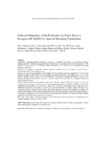Mostrar o rexistro simple do ítem
Cultural adaptation of the evaluation in Ayres Sensory Integration® (EASI) for spanish-speaking populations
| dc.contributor.author | Gándara-Gafo, Berta | |
| dc.contributor.author | Beaudry-Bellefeuille, Isabelle | |
| dc.contributor.author | Mailloux, Zoe | |
| dc.contributor.author | Moriyón, Tania | |
| dc.contributor.author | Parham, L. Diane | |
| dc.contributor.author | Santos-del-Riego, Sergio | |
| dc.contributor.author | Serrada-Tejeda, Sergio | |
| dc.contributor.author | Roley, Susanne Smith | |
| dc.contributor.author | Toledo, Pilar | |
| dc.contributor.author | Schaaf, Roseann C. | |
| dc.date.accessioned | 2021-10-25T07:45:20Z | |
| dc.date.available | 2021-10-25T07:45:20Z | |
| dc.date.issued | 2021-09-16 | |
| dc.identifier.citation | Gándara-Gafo B, Beaudry-Bellefeuille I, Mailloux Z, Moriyón T, Parham D, Santos-del Riego S, et al. Cultural adaptation of the evaluation in Ayres Sensory Integration® (EASI) for spanish-speaking populations. Am J Occup Ther. 2021;75(5):7505205090 | es_ES |
| dc.identifier.issn | 0272-9490 | |
| dc.identifier.uri | http://hdl.handle.net/2183/28711 | |
| dc.description.abstract | [Abstract] Importance: Spanish-speaking populations represent a significant percentage of occupational therapy clientele globally. Culturally appropriate Spanish translations of assessments are therefore imperative. This study describes the process of a culturally adapted translation of a set of tests for use with Spanish-speaking pediatric populations. Objective: To produce a culturally adapted Spanish translation of the Evaluation in Ayres Sensory Integration® (EASI) for international use. Method: We used cultural adaptation methodology that included direct and back translations of the EASI by bilingual translators and interviews with pediatric occupational therapists and children ages 3–6 yr from Spain. Linguistic experts helped revise the translations, and pediatric occupational therapy leaders in five Spanish-speaking North and South American countries reviewed the translations for comprehensibility and cultural appropriateness. Results: Back translations demonstrated equivalence with the original EASI tests except for a few test instructions and scoring criteria. Interviews with occupational therapists and children in Spain revealed some comprehension difficulties for several tests, which were revised in consultation with a linguistic expert. Additional adaptations were made on the basis of recommendations to address cultural differences by occupational therapy leaders from five North and South American countries. Most changes in wording were made in one EASI test (Praxis: Following Directions) that is heavily dependent on language comprehension. Conclusions and Relevance: We used currently recommended methodologies to develop and adapt a Spanish translation of the EASI for use across diverse cultures. What This Article Adds: A Spanish translation of the EASI has been developed for use in culturally diverse Spanish-speaking countries around the world. | es_ES |
| dc.language.iso | eng | es_ES |
| dc.publisher | AOTA (American Occupational Therapy Association) | es_ES |
| dc.relation.uri | https://doi.org/10.5014/ajot.2021.044693 | es_ES |
| dc.subject | Child | es_ES |
| dc.subject | Linguistics | es_ES |
| dc.subject | Occupational therapists | es_ES |
| dc.subject | Pediatrics | es_ES |
| dc.subject | Sensory integration | es_ES |
| dc.subject | Spain | es_ES |
| dc.subject | Bilingualism | es_ES |
| dc.title | Cultural adaptation of the evaluation in Ayres Sensory Integration® (EASI) for spanish-speaking populations | es_ES |
| dc.type | info:eu-repo/semantics/article | es_ES |
| dc.rights.access | info:eu-repo/semantics/openAccess | es_ES |
| UDC.journalTitle | American Journal of Occupational Therapy | es_ES |
| UDC.volume | 75 | es_ES |
| UDC.issue | 5 | es_ES |
| UDC.startPage | 7505205090 | es_ES |






